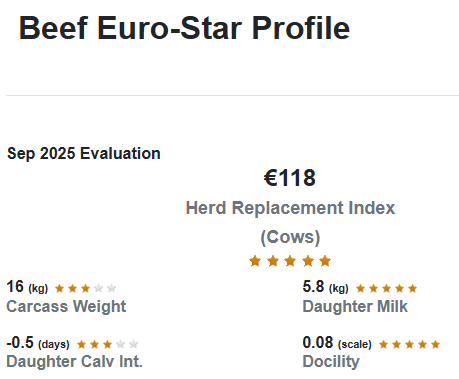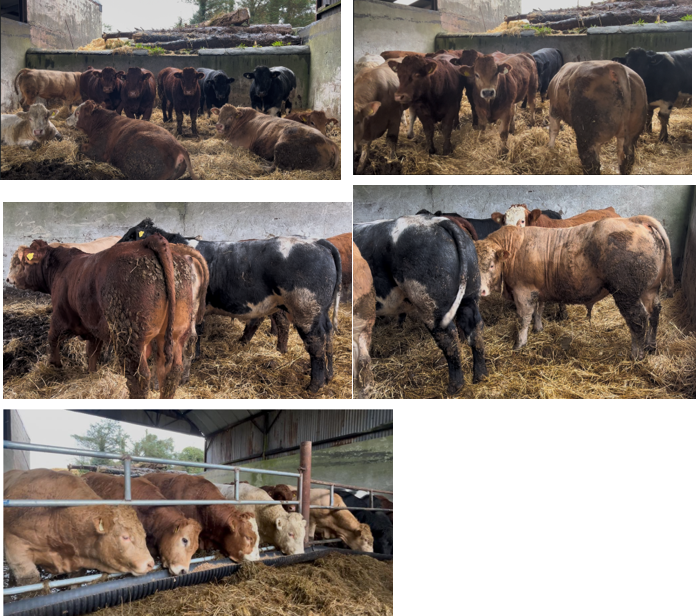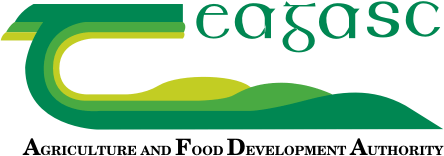Breeding
The autumn calving herd has almost finished calving and will now commence breeding from the 5th to the 7th of November. A Team of bulls will be used to breed replacements from the highest performing cows using the suckler cow report to identify these animals. An easy calving angus bull will be chosen for the heifers and the remaining maternal bulls will be mainly Limousin and Simmental. The main focus for the breeding programme will be to improve carcass, milk and fertility traits. The current herds Eurostar index can be seen in figure 1.

Figure 1: Beef Eurostar profile
The team of bulls used on the herd for producing replacements were mainly Limousin bulls with some Simmental used also (see figure 2). The Angus sire AA9661 was used on heifers with the aim of minimising calving difficulty, getting the heifer back in calf again. Terminal bulls used in the herd included CH8580, BA4661, LM8619, BB4438, LM2014 and LM9622.
| Bull code | Replacement Index € | Carcass weight kg | Milk kg | Calving interval days |
| LM7599 | 107 | 34.9 | 41 | 2.8 |
| AA9661 | 142 | 13.5 | 5.5 | -4.37 |
| LM8929 | 174 | 23.2 | 6 | 2.8 |
| LM8109 | 115 | 27.1 | 7.6 | 2.85 |
| SI4147 | 139 | 32.1 | 9.3 | -1.03 |
| LM9948 | 160 | 30.1 | 2.4 | 0.5 |
| Average | 140 | 26.8 | 11.9 | 0.59 |
| Herd | 118 | 16 | 5.8 | -0.5 |
| Autumn calves 25 | 129 | 21.4 | 8.8 | 0.04 |
Figure 2: Bulls used for producing replacements in 2025
As mentioned above a big focus is placed on calving ease for the 1st calvers in the herd. All the heifers calve down as 24 month old heifers and the aim is to retain these heifers within the herd as long as they are performing well. Easy calving sires are used and the body condition of these animals is assessed regularly. Currently the autumn calvers are outdoors but will be housed from the 1st week of November for the breeding season, the autumn calvers will be fed the highest quality silage available and any thin cows or first calvers will also receive 1-1.5kg of ration daily. Pictured in figure 3 are 1st calvers made up mainly by Limousin cross Simmental.

Figure 3 shows some of the 1st calvers mainly Limousin X Simmental. The heifer in the middle 857 has a replacement index of €136 with milk, carcass weight and daughter calving interval ptas of 4.7kg, 16kg and -0.72days respectively.
The autumn born calves will have access to creep grazing once housed this works well from the point of view of breaking the calf cow bond and helping to get cows cycling. Calves are also offered ration over the winter period in the creep area. Figure 4 shows some of the autumn born calves outside.

Figure 4: 2025 Autumn born calves
Performance
The autumn 2024 bulls were weaned from the cows on the 1st of July and were paddocked grazed for a month outdoors on grass. On the 1st of august the bulls were housed. At housing the bulls were faecal egg sampled and as a result of a high worm burden, they were treated with Albex. The backs and tails of the bulls were clipped and they were also treated for lice. The bulls will be treated for lice again in early to mid November. The Kingston’s do not treat for liver fluke as historically they do not have an issue with fluke from monitoring factory reports.
The bulls were started on a 15% crude protein high energy maize based ration and were started on 2kg daily plus ad lib silage. This was increased weekly up to 10kg ration plus ad lib silage. The bulls are fed at least twice daily and have fresh water available which is cleaned daily. The target finish date for the bulls is early to mid December and as the bulls near finish the plan is to reduce the crude protein of the ration down to 12% and continue to feed a high energy nut. Figure 5 shows the ingredients in the current ration.

Figure 5: Feed ingredients in the bull finishing ration
The bulls were normally finished on slats, however there were issues with them being housed alongside heifers, which lead to more aggressive behaviour between herd mates and also the bulls were tight for space. On 2 of the previous years bulls also suffered from damaged hoof claws. A decision was made to convert a dry store to a loose straw bedded shed. The bulls are allocated 3.5m2 per head for lying space and any effluent is also collected in a slatted tank next door to the shed. The bulls can be bedded from outside in order to maintain safety. The shed is also adjacent to a cattle handling facility which can be used for loading animals for the factory or clipping or treating for lice etc. These bulls were weighed on the 2nd of June and weighed 415kg at the time averaging 1.32kg since birth. With the new set up, it should make it easier to carry out more weighings in the future during the finishing period to monitor weight gains.

Figure 6: Autumn 2024 born young finishing bulls
Getting winter ready and spring calving herd
This year new feed barriers were installed in the existing finishing pens and new dividing gates were also installed. The winter housing was looked at back in August and animal space requirements were examined. Animals were too tightly housed during the finishing period leading to a possible reduction in carcass weights. The existing shed which was used as a dry store and converted into a straw bedded shed for finishing bulls has freed up more room for other animals at housing.
The spring born weanlings have been weaned and these animals are currently housed and receiving good quality silage and 2 kg of ration. The spring calving suckler cows were not put in calf and will be finished indoors over the winter period. The spring born weanlings were also weighed on the 2nd of June. At that stage they weighed 201kg and had gained 1.39kg of liveweight per head.

Figure 8: 3 Spring 2025 born calves sired by left to right, LM2014 Ewdenvale Ivor, CH8580 Romarin, LM8616 Lisnar Sir
